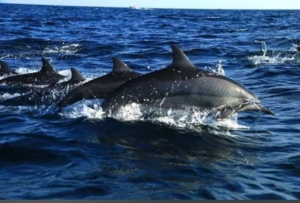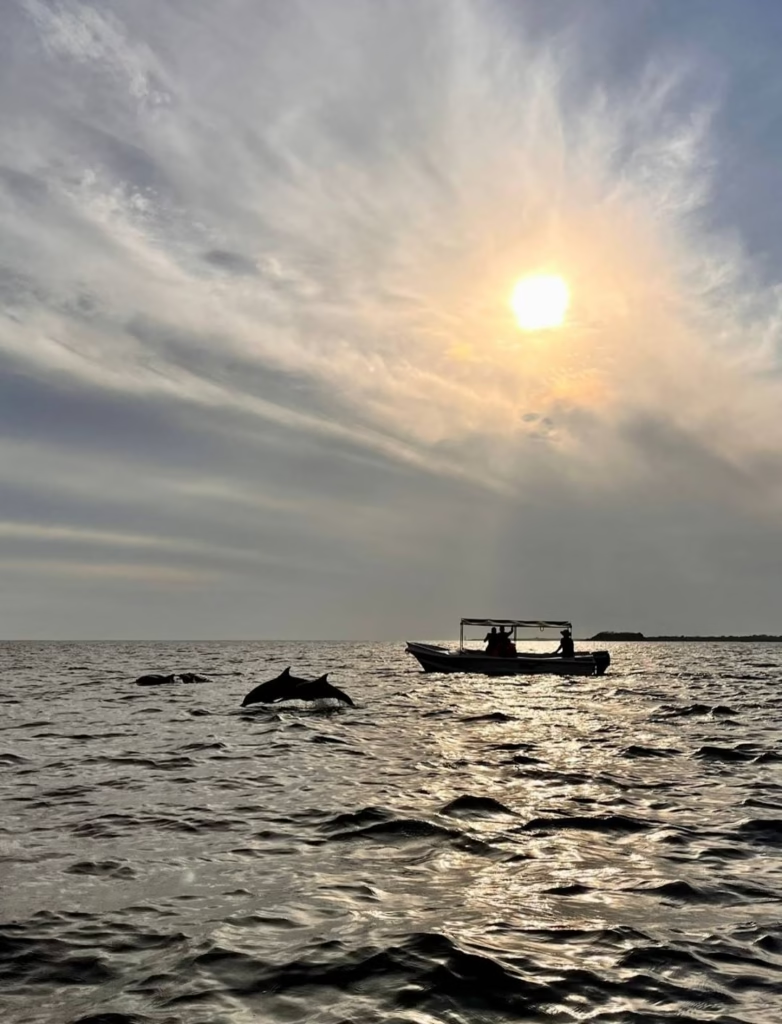Dolphin Watching Trincomalee – An Unforgettable Ocean Adventure
Dolphin Watching Trincomalee , a coastal paradise on Sri Lanka’s eastern shores, is one of the best destinations for dolphin watching. With the Indian Ocean’s crystal-clear waters and abundant marine life, this region offers a spectacular opportunity to witness these playful creatures in their natural habitat.
Why Trincomalee for Dolphin Watching? CLICK HERE MORE INFO
Trincomalee is known for its rich marine biodiversity, and its waters are home to several species of dolphins, including: Dolphin Watching Trincomalee
Common Dolphins – Often seen in large pods, making for a breathtaking sight.
Spinner Dolphins – Famous for their acrobatic spins and playful nature.
Bottlenose Dolphins – Known for their intelligence and curiosity towards boats.
Risso’s Dolphins – Recognized by their unique greyish-white bodies.
Best Time for Dolphin Watching
The best time to experience dolphin watching in Trincomalee is from March to September, when the sea is calm, and the chances of spotting dolphins are high. During these months, dolphins can be seen in large pods, gracefully swimming and leaping out of the water.
The Dolphin Watching Experience
A typical dolphin watching tour begins early in the morning, around 6:00 AM to 7:00 AM, when the ocean is at its calmest. The boat ride takes you a few kilometers into the sea, where you’ll witness pods of dolphins swimming, jumping, and playing in the waves. Some tours may also include the chance to spot whales, such as the magnificent blue whale and sperm whale, adding to the thrill of the experience.
Tips for an Amazing Dolphin Watching Tour
- Book with a Reputable Tour Operator ( Pigeon Island Tours ) – Ensure safety and ethical dolphin watching practices.
- Bring a Camera – Capture breathtaking moments as dolphins leap through the waves.
- Wear Comfortable Clothing – Light and breathable attire with sun protection is ideal.
- Don’t Forget Sunscreen & Sunglasses – The sun can be intense out at sea.
- Respect Marine Life – Avoid loud noises and sudden movements to not disturb the dolphins.
Why You Shouldn’t Miss Dolphin Watching in Trincomalee
Dolphin watching in Trincomalee is a truly magical experience. The sight of these majestic marine mammals in their natural environment is both thrilling and serene. Whether you’re a nature lover, a photography enthusiast, or simply someone looking for an unforgettable adventure, this oceanic journey is a must-do activity in Sri Lanka.
Plan your dolphin watching tour in Trincomalee and immerse yourself in the wonders of the deep blue sea!
Duration – 2 Hours



Best Time for Dolphin Watching Trincomalee
Dolphin watching in Trincomalee is one of the most thrilling marine experiences in Sri Lanka. The deep waters of the Indian Ocean, just off the coast of Trincomalee, are home to various species of dolphins and whales, making it a prime location for dolphin-watching tours.
Best Time for Dolphin Watching in Trincomalee
The best time to go dolphin watching in Trincomalee is between March and August, when the sea is calmer and dolphins are more active near the coast.
Types of Dolphins You Can See
Visitors can witness different species of dolphins, including:
Striped Dolphins
Spinner Dolphins (the most common and famous for their acrobatics)
Bottlenose Dolphins
Risso’s Dolphins
Spinner Dolphins (Stenella longirostris) – The Acrobats of the Ocean – Dolphin Watching Trincomalee
Spinner dolphins are one of the most commonly sighted dolphin species in Trincomalee and are famous for their spectacular spinning jumps. These dolphins are playful, social, and highly energetic, making them a favorite among dolphin watchers.
Key Features of Spinner Dolphins
Lifespan: Can live up to 20 years in the wild.
Size: Typically 1.3 to 2.1 meters long.
Weight: Weigh between 23 to 80 kg.
Color: A distinct three-tone color pattern—dark gray on the back, lighter gray on the sides, and a white belly.
Beak: They have a long, slender beak compared to other dolphins.
Why Are They Called “Spinner” Dolphins?
Spinner dolphins are named after their unique ability to leap out of the water and spin multiple times in the air before landing. They can perform up to seven full spins in a single jump! Scientists believe they spin to:
- Communicate with each other.
- Remove parasites from their skin.
- Show off during mating displays.
- Simply have fun!
Behavior & Social Life
- Highly Social: They live in pods ranging from a few individuals to over 100 dolphins.
- Day & Night Activity: They rest during the day in shallow waters and hunt at night in deeper waters.
- Vocal Communication: Use clicks, whistles, and body movements to communicate.
Where Can You See Them in Trincomalee?
Spinner dolphins are best spotted just off the coast of Trincomalee in the deep waters of the Indian Ocean. They are usually seen in large pods early in the morning, performing their iconic acrobatics.
Best Time to See Spinner Dolphins in Trincomalee
- March to August (calm seas, high chance of sightings).
- Early morning (6:00 AM to 8:00 AM) is the best time to catch them in action.
Bottlenose Dolphins (Tursiops truncatus) – The Intelligent and Playful Marine Mammal – Dolphin Watching Trincomalee
Bottlenose dolphins are one of the most well-known and widely recognized dolphin species. These highly intelligent and social creatures can be found in oceans around the world, including the waters off the coast of Trincomalee, Sri Lanka.
Physical Characteristics
- Size: 2 to 4 meters (6.6 to 13 feet) in length
- Weight: 150 to 650 kg (330 to 1,430 lbs)
- Color: Light to dark gray on top, with a lighter belly
- Lifespan: 40 to 60 years in the wild
Habitat and Distribution
Bottlenose dolphins live in both warm and temperate waters, including coastal and deep-sea environments. In Trincomalee, they can often be seen swimming in pods, playing, and sometimes approaching boats out of curiosity.
Behavior and Intelligence
- Highly Social: They live in pods of 10 to 30 members but can form larger groups when food is abundant.
- Playful Nature: They love to surf on waves, leap out of the water, and play with objects, including seaweed and even fish.
- Communication: They use a variety of clicks, whistles, and body movements to communicate with each other.
- Problem Solvers: Considered one of the most intelligent marine species, they can recognize themselves in mirrors and use tools, such as sponges, to protect their snouts while hunting.
Diet and Hunting
Bottlenose dolphins mainly eat fish, squid, and crustaceans. They use echolocation (a type of biological sonar) to locate prey, emitting sound waves and interpreting the echoes that bounce back.
Threats and Conservation
- Natural predators: Sharks, including tiger sharks and great white sharks.
- Human threats: Pollution, fishing nets, and habitat destruction.
- Conservation efforts: Protected under various international agreements, and many organizations work to ensure their survival in the wild.
Where to See Bottlenose Dolphins in Trincomalee?
Bottlenose dolphins can be spotted during dolphin-watching tours in Trincomalee, especially between March and August. They often swim close to boats, giving tourists a great view of their playful behavior.
Risso’s Dolphins (Grampus griseus) – The Unique Deep-Sea Dolphins – Dolphin Watching Trincomalee
Risso’s dolphins are a fascinating species often spotted during dolphin-watching tours in Trincomalee. Unlike other commonly seen dolphins, they have a distinctive appearance and a preference for deeper waters.
Physical Features of Risso’s Dolphins
- Size: Can grow up to 4 meters (13 feet) long and weigh between 300–500 kg.
- Color: Dark gray when young but turn lighter with age due to scars covering their bodies. These scars come from social interactions, squid bites, and encounters with predators.
- Head Shape: Unlike most dolphins, Risso’s dolphins lack a pronounced beak and have a bulbous, rounded forehead (melon).
Where to See Risso’s Dolphins in Trincomalee?
Risso’s dolphins prefer deep offshore waters, making Trincomalee an ideal location for spotting them. They are often seen:
- Swimming in small pods (groups of 5–50 dolphins).
- Breaching (jumping out of the water) and spy-hopping (raising their head above water to observe their surroundings).
- Interacting with other dolphin species like bottlenose and spinner dolphins.
Diet & Behavior
- Food: Primarily squid, but also eat small fish and crustaceans.
- Diving Ability: They can dive up to 1,000 meters (3,280 feet) to hunt for squid.
- Social Behavior: Known for their playful but shy nature, they use body contact as a way of communication.
Why Are They Special?
- Unlike other dolphins, their scarring makes them easily identifiable.
- They can live up to 35 years.
- One of the largest dolphin species, almost resembling a small whale.
Striped Dolphins (Stenella coeruleoalba)
Striped dolphins are a fascinating species often seen in the waters of Trincomalee. They are known for their striking body patterns and energetic behavior.
Physical Characteristics
- Size: They grow between 1.8 to 2.5 meters (6–8 feet) in length.
- Weight: Can weigh between 90 to 150 kg (200–330 lbs).
- Color: Their name comes from the distinct blue-gray body with dark blue or black stripes running from the eye to the flippers and tail.
- Shape: They have a slender body and a long, narrow beak.
Behavior & Habitat
- Striped dolphins are highly social and often travel in large pods of 100 or more individuals.
- They are famous for their high-energy jumps, flips, and spins out of the water.
- These dolphins prefer deep offshore waters, making the deep seas of Trincomalee an ideal location to spot them.
- They can swim at high speeds and often interact with boats, riding the waves created by them.
Diet
- They primarily feed on small fish, squid, and crustaceans.
- They use echolocation to detect prey and hunt in coordinated groups.
Best Time to See Striped Dolphins in Trincomalee
The best time to spot striped dolphins in Trincomalee is between March and August, when the ocean is calm, and they are more likely to surface in search of food.
Dolphin Watching Trincomalee Dolphin Watching Trincomalee Dolphin Watching Trincomalee Dolphin Watching Trincomalee Dolphin Watching Trincomalee Dolphin Watching Trincomalee Dolphin Watching Trincomalee Dolphin Watching Trincomalee Dolphin Watching Trincomalee Dolphin Watching Trincomalee Dolphin Watching Trincomalee Dolphin Watching Trincomalee
Dolphin Watching Trincomalee Dolphin Watching Trincomalee Dolphin Watching Trincomalee Dolphin Watching Trincomalee Dolphin Watching Trincomalee Dolphin Watching Trincomalee Dolphin Watching Trincomalee Dolphin Watching Trincomalee Dolphin Watching Trincomalee Dolphin Watching Trincomalee Dolphin Watching Trincomalee Dolphin Watching Trincomalee
![]()
